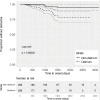How much risk does delirium represent for the development of dementia?: Retrospective cohort study from over 260,000 patients record in a solitary institution
- PMID: 39345923
- PMCID: PMC11427876
- DOI: 10.3389/fpsyt.2024.1387615
How much risk does delirium represent for the development of dementia?: Retrospective cohort study from over 260,000 patients record in a solitary institution
Abstract
Background: Delirium frequently affects the consciousness of the elderly, particularly those in hospitals. Evidence increasingly associates linking delirium history to an increased risk of dementia. However, most studies are limited in scope, focusing mainly on postoperative or intensive care units with small patient samples, which affects the broader applicability of their findings.
Aims: To elucidate the precise incidence of delirium and the subsequent onset of dementia within whole inpatients. Additionally, we aimed to explore the correlation between the emergence of delirium during hospitalization and the subsequent manifestation of dementia.
Design setting and participants: We conducted a retrospective cohort analysis employing a decade-long electronic medical record dataset consisted of 261,123 patients in Osaka Medical and Pharmaceutical University Hospital. Key analyses were performed October 2022 to January 2023.
Main outcomes and measures: The primary outcome, dementia onset, was determined by prescriptions for the anti-dementia drugs donepezil, galantamine, memantine, or rivastigmine, which are approved for use in Japan.
Results: 10,781 patients met the inclusion criteria. The median interval between the onset of dementia was 972.5 days for individuals without a history of delirium, whereas for those with a history of delirium, it was notably shorter at 592.5 days. This disparity culminated in a hazard ratio of 5.29 (95% confidence interval: 1.35-20.75) for subsequent dementia onset.
Conclusions and relevance: This investigation underscores the imperative significance of directing attention toward preventive measures against delirium during hospitalization, alongside the necessity of diligent monitoring and intervention for cognitive decline in patients who encounter delirium.
Keywords: cognitive decline; delirium; dementia; retrospective cohort study; subsequent dementia onset.
Copyright © 2024 Minami, Toyoda, Hata, Nishihara, Neo, Nishida and Kanazawa.
Conflict of interest statement
The authors declare that the research was conducted in the absence of any commercial or financial relationships that could be construed as a potential conflict of interest.
Figures


Similar articles
-
Long-Term Impact of Delirium on the Risk of Dementia in Hospitalized Older Patients: A Real-World Multicenter Study.Am J Geriatr Psychiatry. 2025 Feb;33(2):123-139. doi: 10.1016/j.jagp.2024.08.004. Epub 2024 Aug 21. Am J Geriatr Psychiatry. 2025. PMID: 39237374
-
Delirium in older medical inpatients and subsequent cognitive and functional status: a prospective study.CMAJ. 2001 Sep 4;165(5):575-83. CMAJ. 2001. PMID: 11563209 Free PMC article.
-
Delirium and incident dementia in hospital patients in New South Wales, Australia: retrospective cohort study.BMJ. 2024 Mar 27;384:e077634. doi: 10.1136/bmj-2023-077634. BMJ. 2024. PMID: 38537951 Free PMC article.
-
Interventions for preventing intensive care unit delirium in adults.Cochrane Database Syst Rev. 2018 Nov 23;11(11):CD009783. doi: 10.1002/14651858.CD009783.pub2. Cochrane Database Syst Rev. 2018. PMID: 30484283 Free PMC article.
-
Neuraxial versus general anesthesia in elderly patients undergoing hip fracture surgery and the incidence of postoperative delirium: a systematic review and stratified meta-analysis.BMC Anesthesiol. 2023 Jul 22;23(1):250. doi: 10.1186/s12871-023-02196-9. BMC Anesthesiol. 2023. PMID: 37481517 Free PMC article.
References
-
- Brodaty H, Henry Brodaty A, Donkin M. Who are informal caregivers? Family caregivers of people with dementia. Dialogues Clin Neurosci. (2009) 11(2):217–28. www.dialogues-cns.org. - PMC - PubMed
LinkOut - more resources
Full Text Sources
Miscellaneous

